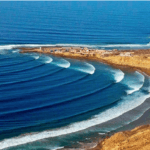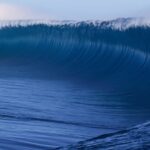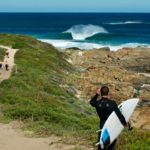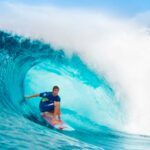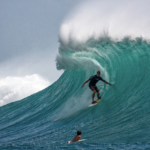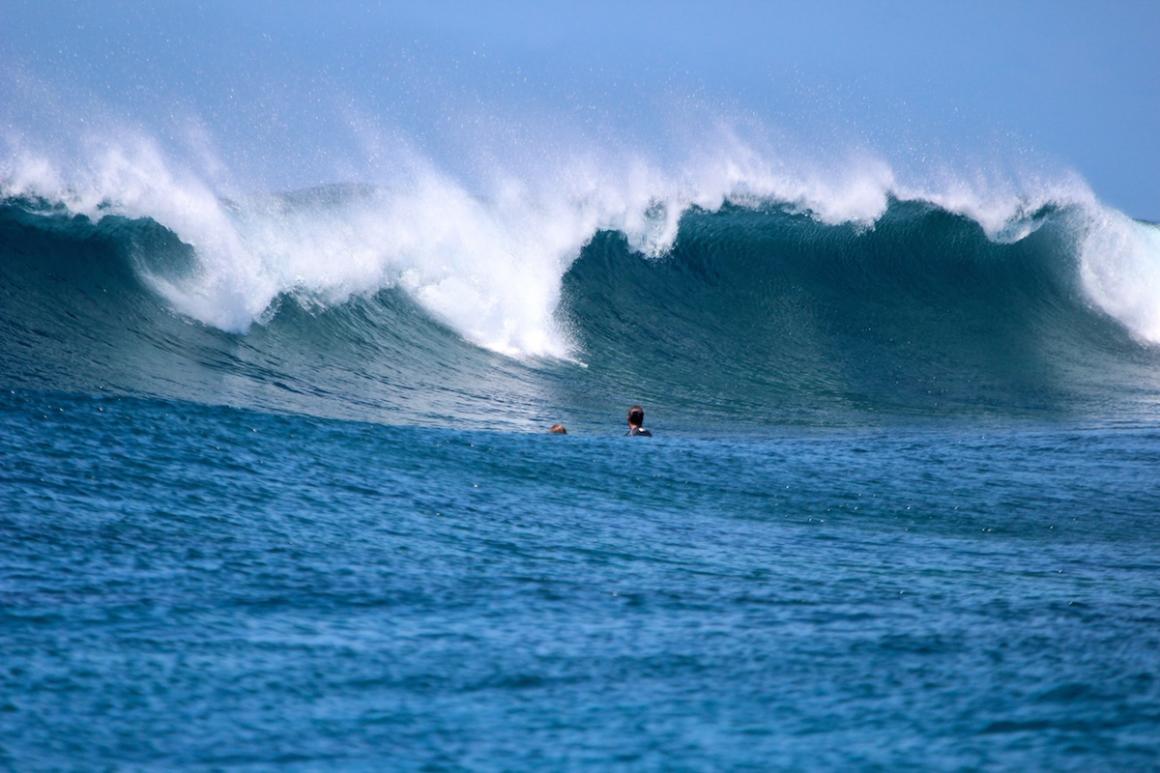
Everything you need to know before starting your surf trip to the Maldives.
HISTORY OF SURF IN MALDIVES
The history of surf in Maldives is like an adventure story with explorers. Everything began when two australian travellers, Tony Hussein-Hinde and Mark Scanlon were sailing through the Male Atolls in 1970. Their boat ran ashore and whilst they were trying to salvage the situation, Hinde observed the corals, and diagnosed that those reefs were perfect for the formation of waves with a bit of wind. Hinde went on to discover the majority of the best breaks of the Maldives and started the first private surf resort of the area, in front of Pasta Point.
And without a doubt they were right: Tony and Mark found el Dorado, a surfers Mecca. Tony married a local woman and surfed these waves in solitary for 15 years, keeping the secret and living the perfect dream. As quoted by Tony – “I had to show locals how to surf so as to have someone to enter the water with”.
But a secret like this couldn’t be kept eternally… Hinde opened an adventure company at the beginning of the 90’s, and a few years later there were many companies bringing hundreds of surfers from all over the globe.

SURF TODAY
Surf is a relatively new sport for the Maldives, in comparison to other more established activities, like diving/snorkelling.
Even though it appeared lately, the O’neill Deep Blue competition put this place on the map for surf worldwide. Even though the majority of the surfers remain around the Male Atoll, there are many breaks to be discovered.
There is a wide variety of breaks, from smooth waves to potent tubes.
The surf area covers the North and South Male Atolls, capital of the Maldives and location of the international airport.
The North Zone offers the famous right-hander infront of the Hudhuran Fushi Resort (before known as Lohifushi), home of the WQS “Deep Blue Open” during the last 3 years.
The waves of the coral reef barrier aren’t easy to surf, the depth is shallow and the corals are sharp and sticking out.
SURF SEASONS IN THE MALDIVES
The Maldives has a similar surf seasons to Indonesia, conditioned by the Monsoons.
The best time to surf coincides with the South-West Monsoon and is from mid-Februrary to November, when the best waves from the Indic Ocean are generated by the winter low pressure systems. March and April boast excellent surf and climate conditions, but it is between March and October when these great waves come in, with the big swell being in July-August. During these months, the predominant wind is offshore, and waves range from 2-8 feet.
The first half of the season is stable, with a lot of light and favourable winds. The swell improves in consistency and reaching February heights during the months of March, April and May.
September and October are also very consistent months whereas waves are concerned, with variable winds and tropical storms being less frequent. November is characterised by its medium-small waves, with perfect weather.
It is recommended to bring all necessary equipment as there are few specialised surf shops on the island. It’s possible to find short boards useful for the majority of the conditions found in the Maldives, however, it is recommendable to take a longer board for those bigger waves. A repair kit, two sets of fins and two leashes would be some useful things to take with you on your trip.
A good souvenir from this type of trip is to grab a book made by one of the many photographers of the area, such as Richard Kotch, who will materialise your unforgettable experience in the Maldives.
In the warm and crystal waters of the Maldives it is not necessary to use a wetsuit, but it is recommended to use a Lycra (preferably long sleeved) as this will protect you from the sun, as well as some strong sun cream. It is also recommended to use a helmet in those reefy areas.
For when your not surfing, pack some light cotton clothes to help you tolerate the tropical climate.

CATCHING WAVES
You don’t think that for being in the middle of the Indic Ocean there won’t be that many people lining up to surf, or do you? While the 30 hour journey can put most people off, it still attracts many tourists and surfers.
Not only this, but the Maldives locals are taking a go at surfing more and more by the minute – but don’t worry, there are plenty of waves to enjoy.
DANGERS OF SURFING IN THE MALDIVES
Even though reefs tend to be quite sharp, and here you will be surfing above them most of the time, these ones are acceptably flat and slightly curved. Even with a low tide the waves don’t break directly on top of the reefs, so no need to worry too much. Currents are another story; if you’re not careful enough you might get trapped within one and taken out to sea. Watch the tides and stay near to the shore line-up. Also don’t forget you are in the Maldives, so drink plenty of water!
FAMOUS WAVES IN THE NORTH AND SOUTH MALE ATOLLS
Chickens: Villingilimathi Huraa (Kuda Villingili), deserted island. North Male reef: requires speed. Excellent long left-hander with two sections, big lip and perfect to surf. However the conditions must be perfect otherwise it can’t be surfed. The best winds are NW-NNW (offshore), and access must be by boat. The name is due to a chicken factory located on the atoll in front of the wave.
Cokes: Thulusdhoo, capital Atoll. North Male reef: short but intense trip. Large tube wave, being one of the most consistent and explosive waves in the Maldives. This wave is better mid-tide, but can be surfed at a push on a low tide. The name is due to their being a Coca Cola factory in front of the wave, and can also only be accessed by boat. NW winds, but can be surfed in any wind from W to N.
Lohis: North Male reef: It needs a lot of strength and a high tide for it to be a good wave. It forms better with NW-NE winds, and can be accessed only by those people staying at the Lohis resort.
Piddlies / Ninjas: Kanifinolhu Resort. North Male reef : easiest wave in the Maldives, perfect for beginners. Better with W-NW wind with moderated S winds. The resort you can find in front of this wave is the Club Med.
Pasta Point: Resorts Dhonveli. North Male Atoll. Perfect, consistent long left-hander, Macaroni Bowl tube, cutback mellows, fast lockjaws and a final tube section. Between 75 and 100 yards long. Reserved exclusively for guests of the Dhonveli resort, and with a maximum limit of 30 surfers. Good with NE-NW winds. Access from the shore.
Sultans (Thamburudhoo Right): Thamburudhoo, deserted island. North Male Atoll. A perfect long right hander wave. Always available, and perfect for practicing tricks and manoeuvres. Between 100 and 150 yards long, better with a high tide and any winds from W to N.
Honky's (Thamburudhoo left): Thamburudhoo. Deserted island. North Male reef. Long left-hander. Starts small and gains in size and intensity, as it goes around 90º of the atoll- starting at 6 feet and finishing at 8 feet, this last bit called “Fred’s Ledge”. Better with low tides, and E-N winds.
Gurus: Miyaru Faru near the island of Guhli. Deserted Island. South Male Reef. Left-hander with more waves than anywhere else in the South Atolls. Better with N winds and high tides. Access by boat.
Twin Peaks (also known as Left & Rights): Gulhi, deserted island. South Male Reef. Works with a full tide, north winds and offers both right and left-hander wave – thus the name “Twin Peaks”. Access by boat.
Riptides: Guraidhoo, deserted island. South Male reef. Small reefs in the middle of the south channel of the island. Fast right-hander, making it one of the best waves in the area. This area has strong currents, and this wave works better with W-SW winds and can only be accessed by boat.

FAMOUS WAVES IN THE GAAFU DHAALU ATOLL
Kaededhdhoo: Right-hander, island with airport on it, fun when there are a high quantity of waves and the wind comes from the west side of the atoll. Barracuda Point is one of the most powerful right-hander waves of the Maldives.The best time for this wave is from February to April and with NW-N winds, and mid-high tides.
Dhigulaabadhoo: Left-hander wave which can be surfed during all tides, with a high probability of observing a lot of marine life (coral sharks, whales, etc.). This wave can link up to another interior section in which there is more speed and potence.
Rockets: Fun left-hander, not very hollow, but with long wave faces and to be surfed in any tide with W to N winds.
Mulah Kandu: A perfect left-hander that ranges from 3-8 feet.
Castaways: Right-hander surfed in high tides, when waves are higher than 4 feet, the back of the wave breaks, making it a fun wave, where you must continue to the interior of the wave.
Love charms: Left-hander, great wave from start to finish, and great tube on the interior from 2-10 feet and can be surfed with all tides and winds from W to N.


